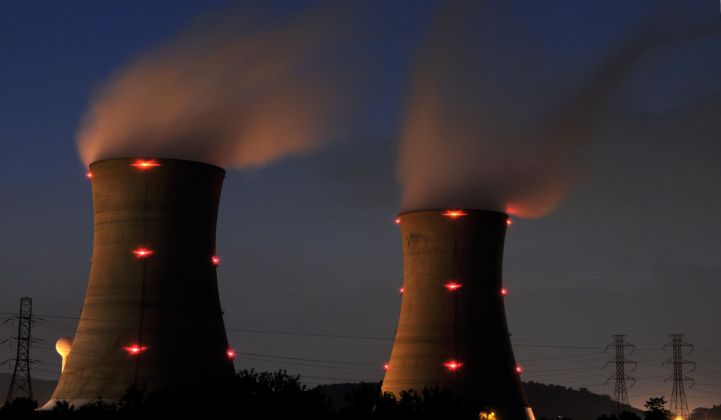Pennsylvania legislators have introduced a bill to shore up two money-losing nuclear power plants that would otherwise close by 2021, by folding them into the state’s 2004 alternative energy portfolio standard for wind, solar and a handful of other energy technologies.
But the long-awaited proposal is facing pushback from ratepayer advocates, natural-gas producers and environmental groups that say it’s a flawed approach, compared to other state-level actions to rescue struggling nuclear plants.
According to bill sponsor Rep. Thomas Mehaffie (R), the proposal will cost $500 million per year, or about $1.77 per month on the typical customer’s bill. Backers of the bill, including the state’s Nuclear Energy Caucus and plant owners Exelon and FirstEnergy, say the costs are worth the benefits of saving two of Pennsylvania’s five nuclear power plants, both in terms of jobs and economic impacts and in terms of the state’s broader carbon reduction efforts.
Opponents, including the AARP and other consumer advocates, have rallied against the bill, claiming it would add more costs than its sponsors have recognized by unnecessarily subsidizing the state’s still-profitable nuclear plants — a move that the state's natural gas industry and energy analysts say will undermine the state’s competitive electricity market.
Environmental groups are opposed to a bill that lacks broader efforts to increase the state’s share of clean energy, which stood at 4.5 percent of generation as of 2017, compared to 42 percent from nuclear, followed by natural gas and coal.
At the same time, Pennsylvania’s nuclear fleet doesn’t emit carbon like the natural-gas- and coal-fired power plants that would likely replace them, making their closure a significant threat to the state’s carbon emissions profile. This same logic has led states to adopt zero-carbon emission credits and other nuclear-supporting policies in states including Illinois, New York and New Jersey.
Unnecessary subsidy?
The bill would create new categories for nuclear power plants under the state’s alternative energy portfolio standard. The existing policy has been criticized by environmental groups for setting aside 10 percent of the Pennsylvania's 18 percent by 2021 mandate for “alternative power producers,” which include carbon-emitting resources such as waste-coal generators and power plants that burn solid waste, as well as large-scale hydro.
The 2004 law also reserves 8 percent of the market for “emerging renewable producers” such as wind, low-impact hydropower, geothermal and biogas, including a 0.5 percent market share for solar PV.
According to The Philadelphia Inquirer, the bill would give the state’s Public Utility Commission the authority to derive a value for the new “Tier III” credits for nuclear power based on the “Tier I” credits for these renewable producers, and to make those credits available to nuclear power plants that serve to establish a positive impact on the state’s air quality. This mechanism of creating a renewable energy credit value for nuclear energy is similar to those established in Illinois, New York and New Jersey.
But critics of the Pennsylvania bill, which was leaked in draft form two weeks ago, say that its flaws outweigh its potential benefits. An independent economic analysis of the bill found it could increase ratepayer costs by as much as $900 million per year, or roughly $5 per month for a typical household bill, compared to the author’s projections, raising the ire of ratepayer advocates.
Opponents have also questioned the wisdom of relenting to pressure from Exelon, owner of the Three Mile Island reactor, and FirstEnergy, owner of the Beaver Valley Nuclear Power Station, which have both announced plans to close the plants by 2021. While the Three Mile Island plant is losing money, Beaver Valley is still profitable. But parent company FirstEnergy Solutions, which filed for bankruptcy protection last year, has threatened to close the plant, along with money-losing coal and nuclear plants in Ohio, absent some form of state intervention.
At the same time, the bill could also extend financial support to the three nuclear power plants that have no plans to close and are projected to remain profitable through 2021, a feature that’s drawn criticism from ratepayer groups that call it an unnecessary subsidy.
Meanwhile, Pennsylvania’s significant natural-gas industry opposes the bill on the grounds that it would increase the share of the state’s energy subject to out-of-market subsidies from its current 18 percent-by-2021 goal, to more than half of the state’s total generation mix — a move they say could undermine its participation in the energy markets of mid-Atlantic grid operator PJM.
Finally, the bill’s impacts may not be enough to save the money-losing Three Mile Island plant, according to a November report by PJM’s independent marketing monitor. Stu Bresler, PJM’s senior vice president of operations and markets, told The Inquirer that the bill will likely result in “upward pressure” on some market prices, but that these pressures may not be enough to save any particular unprofitable power plant from closure.




